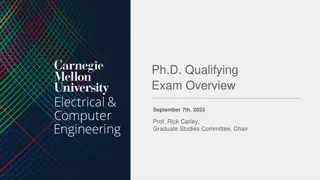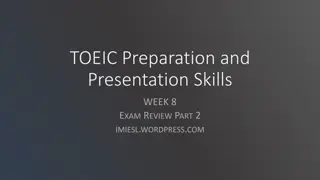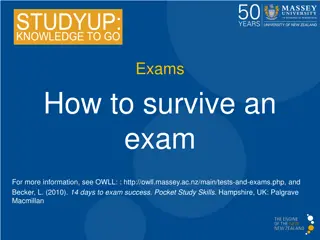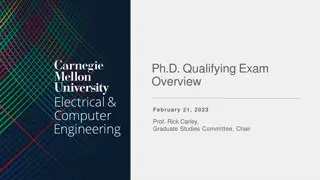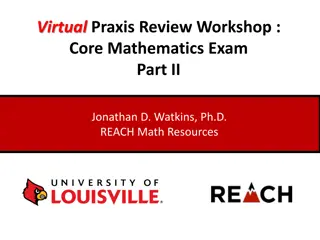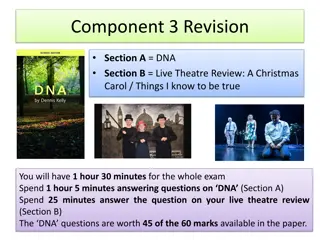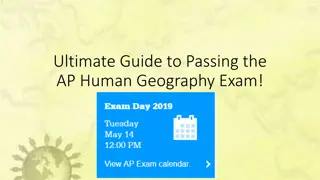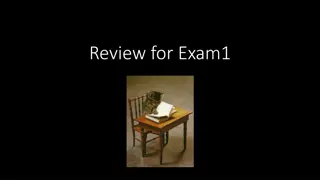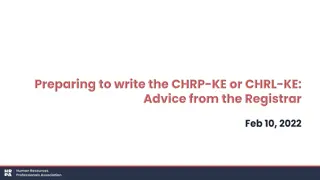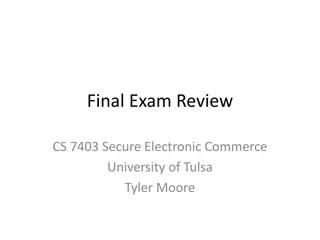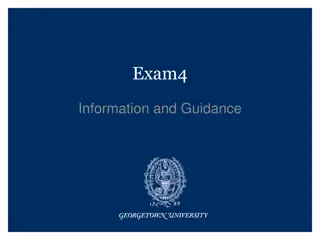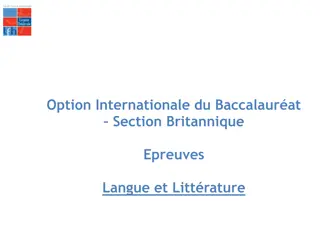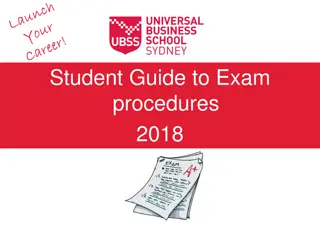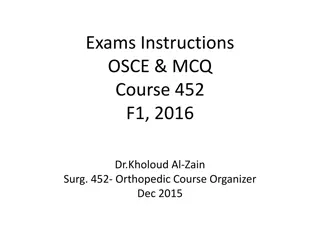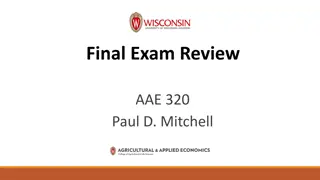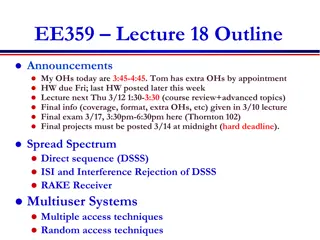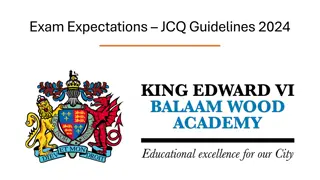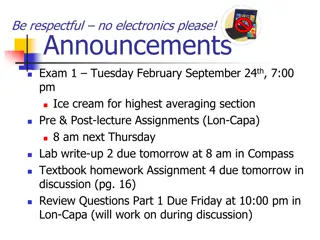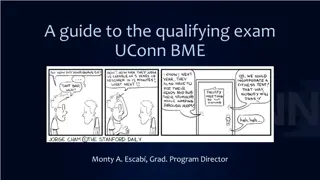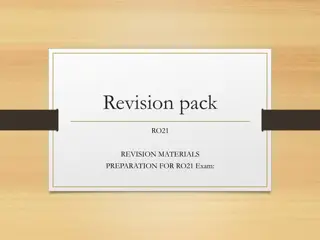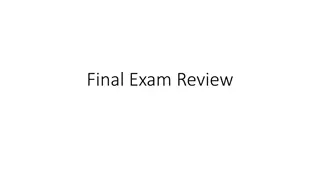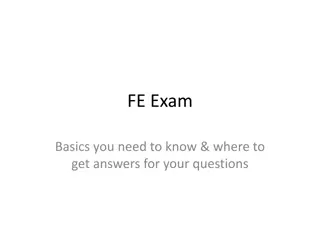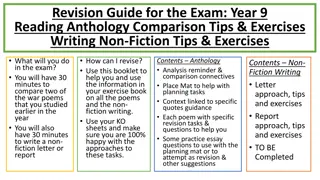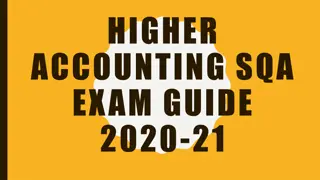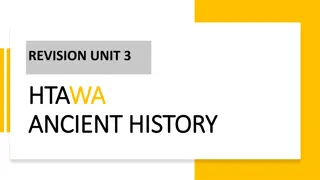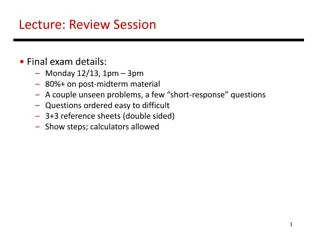Communication Exam Review and Tips
Understanding the key concepts of communication such as barriers, cultural context, nonverbal communication, and critical listening skills is crucial for effective communication. This content covers important topics from developing professional presence to managing the communication process. It also provides scenarios to enhance persuasion skills in different workplace situations.
Download Presentation

Please find below an Image/Link to download the presentation.
The content on the website is provided AS IS for your information and personal use only. It may not be sold, licensed, or shared on other websites without obtaining consent from the author. Download presentation by click this link. If you encounter any issues during the download, it is possible that the publisher has removed the file from their server.
E N D
Presentation Transcript
COM 211 FINAL EXAM REVIEW
CHAPTER 1 DEVELOPING YOUR PROFESSIONAL CHAPTER 1 DEVELOPING YOUR PROFESSIONAL PRESENCE PRESENCE Which of the following concepts helps to explain why communication can fail? A) Transmission B) Medium C) Barriers D) Encoding E) Interaction Answer: C Study Question: 1 Why is it challenging to communicate well?
CHAPTER 1 DEVELOPING YOUR PROFESSIONAL CHAPTER 1 DEVELOPING YOUR PROFESSIONAL PRESENCE PRESENCE During the communication process, which of the following acknowledges that one group's learned behaviors may be different than those of another group? A) Relational context B) Cultural context C) Social context D) Psychological context E) Physical context Answer: B Study Question: 1 Why is it challenging to communicate well?
CHAPTER 2 WORKING WITH OTHERS: INTERPERSONAL, CHAPTER 2 WORKING WITH OTHERS: INTERPERSONAL, INTERCULTURAL, AND TEAM COMMUNICATION INTERCULTURAL, AND TEAM COMMUNICATION A message that is conveyed through something other than words uses what type of communication technique? A) Passive B) Indirect C) Nonverbal D) Interpretive E) Comprehensive Answer: C Study Question: 1 What listening skills will help you communicate better with others?
CHAPTER 2 WORKING WITH OTHERS: INTERPERSONAL, CHAPTER 2 WORKING WITH OTHERS: INTERPERSONAL, INTERCULTURAL, AND TEAM COMMUNICATION INTERCULTURAL, AND TEAM COMMUNICATION Critically reviewing and judging what you hear takes place when _____ communication. A) paraphrasing B) comprehending C) interpreting D) evaluating E) hearing Answer: D Study Question: 1 What listening skills will help you communicate better with others?
CHAPTER 3 MANAGING THE COMMUNICATION CHAPTER 3 MANAGING THE COMMUNICATION PROCESS PROCESS Which would be the best way to persuade your boss to implement a flex-time schedule in your office? A) Provide research that shows that this arrangement is workable and often results in increased productivity B) Give the boss the names of the employees who would be interested in working a flex-time schedule C) Tell the boss how happy it would make you to have the flexibility to accommodate your personal interests D) Inform the boss about the many leisure activities that employees would be able to engage in if the flex-time schedule were implemented E) Tell her that your friend's brother's company is considering a flex-time schedule at its local office Answer: A Study Question: 1 What are the benefits of analyzing?
CHAPTER 3 MANAGING THE COMMUNICATION CHAPTER 3 MANAGING THE COMMUNICATION PROCESS PROCESS When conducting the audience analysis for a persuasive message, which of the following is one of the recommended questions? A) How should you organize the persuasive message? B) What information does the audience need to know and why? C) How should I design the format and delivery? D) Does the content ensure complete information? E) How will I benefit from my idea or proposal? Answer: B Study Question: 1 What are the benefits of analyzing?
CHAPTER 5 COMMUNICATING PERSUASIVE MESSAGES CHAPTER 5 COMMUNICATING PERSUASIVE MESSAGES What is considered to be the most critical element of persuasion? A) Logical argument B) Credibility C) Emotion D) Benefits E) Establishing a problem or need Answer: B Study Question: 2 What are the basic elements of persuasion?
CHAPTER 5 COMMUNICATING PERSUASIVE MESSAGES CHAPTER 5 COMMUNICATING PERSUASIVE MESSAGES If you have thoroughly analyzed all the elements and carefully composed the message, evaluation ________. A) is not recommended B) can be very difficult C) is a must before delivering D) can decrease the persuasive quality E) should be short and superficial Answer: C Study Question: 1 How can the ACE process help you persuade your audience?
THE ETHICS OF BUSINESS (WEEK 6/7 UPDATE) THE ETHICS OF BUSINESS (WEEK 6/7 UPDATE) Which of the following statements about ethics is NOT true? A) Ethics is not the same thing as feelings B) Ethics isn t simply religion C) Ethics isn t merely following the law D) Ethics isn t simply knowing what we ought to do E) Ethics isn t merely following culturally-accepted norms Answer: D
THE ETHICS OF BUSINESS (WEEK 6/7 UPDATE) THE ETHICS OF BUSINESS (WEEK 6/7 UPDATE) What is a good definition of the concept of appropriation? A) Acknowledging the work of others in your own work B) When our interest in something comes in conflict with our duties or responsibilities C) When we respond to a situation based on how we are affected by the way the situation is presented to us D) Our tendency to adopt behavior based on others rather than our own judgment E) When we use the work of others and not credit them Answer: E
CHAPTER 8 FINDING AND EVALUATING BUSINESS CHAPTER 8 FINDING AND EVALUATING BUSINESS INFORMATION INFORMATION Which of the following refers to the range of research for a report? A) Purpose B) Scope C) Evaluation D) Complexity E) Benefits Answer: B Study Question: 1 How do you determine what information you need?
CHAPTER 8 FINDING AND EVALUATING BUSINESS CHAPTER 8 FINDING AND EVALUATING BUSINESS INFORMATION INFORMATION What is the advantage to using articles from publications such as the Wall Street Journal? A) They are current B) They offer a wide variety of opinions C) Editors have reviewed them, making them more reliable D) Researchers can find some type of publication to support the goal of the research E) They can be found online Answer: C Study Question: 2 How do you conduct research in print and online sources?
CHAPTER 9 PREPARING PERSUASIVE BUSINESS CHAPTER 9 PREPARING PERSUASIVE BUSINESS PROPOSALS PROPOSALS If your audience doesn t know you, how can you build credibility in the proposal? A) By asking thoughtful questions of the audience B) By identifying areas of concern for the audience C) By explaining what the audience is doing wrong and how they can correct those issues D) By explaining your experience and qualifications E) By identifying what the competition is doing Answer: D Study Question: 1 How do you use ACE to prepare an effective proposal?
CHAPTER 9 PREPARING PERSUASIVE BUSINESS CHAPTER 9 PREPARING PERSUASIVE BUSINESS PROPOSALS PROPOSALS When responding to a competitive proposal, how can a company be sure they are submitting what the audience wants? A) By utilizing information in the RFP B) By meeting with the audience to determine need C) By meeting with competitors to see what they are including D) By responding with a proposal developed based on past experience E) By developing a proposal that includes the lowest cost possible for the audience Answer: A Study Question: 1 How do you use ACE to prepare an effective proposal?
CHAPTER 10 PREPARING BUSINESS REPORTS CHAPTER 10 PREPARING BUSINESS REPORTS What should always be included in a feasibility report? A) Costs associated with implementing the proposal B) Deadlines C) A detailed background on why the report was written D) Criteria that decision makers can use to judge the proposal E) Potential outcomes Answer: D Study Question: 2 What types of short, routine reports are typical in business?
CHAPTER 10 PREPARING BUSINESS REPORTS CHAPTER 10 PREPARING BUSINESS REPORTS Which of the following reports is designed to quickly inform others about the work you have done and to provide documentation for future use? A) Feasibility report B) Progress report C) Evaluation report D) Recommendation report E) Formal report Answer: B Study Question: 2 What types of short, routine reports are typical in business?
CHAPTER 11 PREPARING AND DELIVERING BUSINESS CHAPTER 11 PREPARING AND DELIVERING BUSINESS PRESENTATIONS PRESENTATIONS When composing a presentation, the goal of the content should be to _____. A) change the audience s opinion B) engage the audience and meet their needs C) be presented in bullet points D) include design elements that provide distraction E) include a variety of visual aids Answer: B Study Question: 2 How do you compose the presentation?
CHAPTER 11 PREPARING AND DELIVERING BUSINESS CHAPTER 11 PREPARING AND DELIVERING BUSINESS PRESENTATIONS PRESENTATIONS What is the goal of establishing rapport with the audience? A) To introduce yourself B) To convince the audience that the information is relevant to them C) To motivate the audience D) To allow the audience to feel confident that you have considered their needs in the presentation E) To preview the content of the presentation Answer: D Study Question: 2 How do you compose the presentation?
CHAPTER 4 COMMUNICATING ROUTINE MESSAGES CHAPTER 4 COMMUNICATING ROUTINE MESSAGES AND BUILDING GOODWILL AND BUILDING GOODWILL In addition to an expression of gratitude, what is a typical element found at the end of a routine request? A) An outline of alternative B) An indication of consequences if the request is not fulfilled C) An indication of how to reach the writer D) A call for action E) A reminder of reasons why the request should be granted Answer: D Study Question: 1 How do you compose messages containing questions and requests?
CHAPTER 4 COMMUNICATING ROUTINE MESSAGES CHAPTER 4 COMMUNICATING ROUTINE MESSAGES AND BUILDING GOODWILL AND BUILDING GOODWILL Why should a goodwill message (thank you, congratulatory, or sympathy message) be a handwritten note that is mailed to the recipient? A) It takes longer to get than email B) It displays intent C) It s a responsible use of company resources D) It s a more personal way of communicating and is much more likely to be read E) Work email can be monitored by the company while snail mail is not Answer: D
CHAPTER 6 COMMUNICATING BAD NEWS CHAPTER 6 COMMUNICATING BAD NEWS When possible, which method of delivering bad news is usually the best choice? A) Email B) Face-to-face C) Text D) Phone calls E) Letters Answer: B Study Question: 1 How should you analyze and plan a bad-news message?
CHAPTER 6 COMMUNICATING BAD NEWS CHAPTER 6 COMMUNICATING BAD NEWS If your audience is expecting to hear from you, and the bad news is not a surprise, what organizational approach will benefit the message? A) Goodwill B) Persuasive C) Indirect D) Casual E) Direct Answer: E Study Question: 2 What are effective strategies for composing bad-news messages?
ADDITIONAL QUESTIONS Which of these choices is a correctly formatted APA citation? A) Adams, Brown, & Chase (2018) The story of business communication. Journal of Business Communication, 42 (3), 52-60. B) Adams, R., Brown, C., & Chase, S. (2018). The story of business communication. Journal of Business Communication, 42 (3), 52-60. C) Adams, Robert; Brown, Candice; & Chase, Samuel (2018). The story of business communication. Journal of Business Communication, 42 (3), 52-60. D) Adams, R., Brown, C., & Chase, S. (March, 2018). The Story of Business Communication. Journal of Business Communication, 42 (3), 52-60. E) Adams, R., Brown, C. & Chase, S. (2018). The Story of Business Communication. Journal of Business Communication, 42 (3), pp. 52-60. Answer: B
ADDITIONAL QUESTIONS Which of the following is a correctly-formatted in-text citation? A) Business communication is a method of exchanging written, verbal, and non-verbal messages between parties engaged in commerce activities (Adams, R., Brown, C., & Chase, S., 2018, p. 53). B) Business communication is a method of exchanging written, verbal, and non-verbal messages between parties engaged in commerce activities (Adams, Brown, & Chase, 2018, 53). C) Business communication is a method of exchanging written, verbal, and non-verbal messages between parties engaged in commerce activities (Adams, Brown, & Chase, 2018, p. 53). D) Business communication is a method of exchanging written, verbal, and non-verbal messages between parties engaged in commerce activities (Adams, Brown, & Chase, 2018, p. 53). E) Business communication is a method of exchanging written, verbal, and non-verbal messages between parties engaged in commerce activities (Adams, Brown, and Chase, 2018, 53). Answer: C
ADDITIONAL QUESTIONS When writing a logical argument, which three elements should be included? A) Take a position, defend it, and restate the position. B) Take a position, provide reasons for the position, and restate the position C) Make an argument you think might be logical, come up with some reasons it might be true, and suggest another possible argument D) Take a position, provide reasons for the position, and offer evidence for the reasons E) Make a logical argument, defend it, and come up with some good reasons to defend it Answer: D



